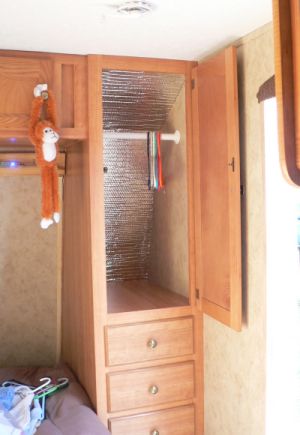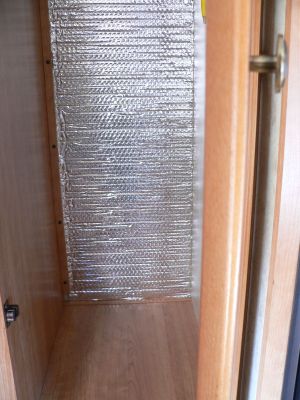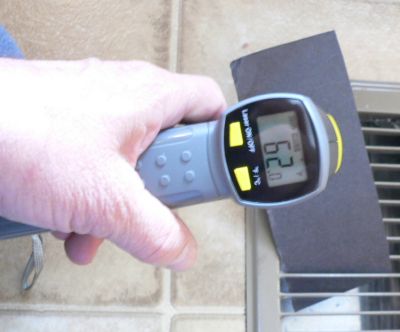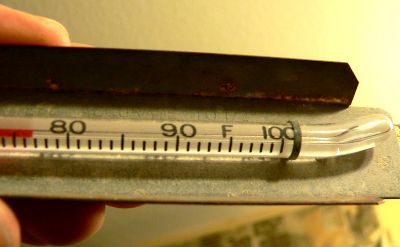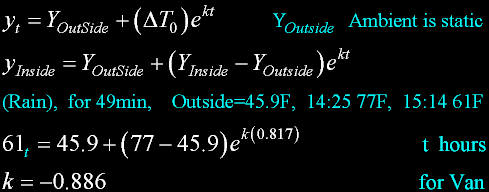index


|
|
RV Maintenance
Thermal Efficiency 2
|
|
 Here is a "half height" closet.
Here is a "half height" closet.
Shown is the back side insulated.
The right side needs to be insulated too: It goes to
the outside.
Also, I will insulate behind these drawers,
and to the right side of these drawers, down below.
Do not insulate the left side wall near the bed.
Full height closet:
Insulate back side, and top. Do not insulate the sides to left and right, these sides do not go to outside,
and will serve as heat reservoirs.
Preparing to remove register; and by hand hold black cardboard in middle of air stream. Then measure heat
with IR thermometer. This is the first of three registers. You must read upstream as close to the furnace as
possible. This will measure the furnace output temperature.
The same method is used at the air intake of the furnace, by holding the cardboard a few inches away from the
input.
We will see the air temperature rise between input and output.
Although handy, this thermometer is very inaccurate.
This my "orchard" thermometer.
Still fairly handy, and very accurate.
I can read to a quarter of a degree!
 Made insulation improvements. Now, I will make another run
of temperature measurements.
The outside temperature is 18.9F degrees, well below freezing.
And the inside temperature is just above freezing at 35.6 degrees.
Made insulation improvements. Now, I will make another run
of temperature measurements.
The outside temperature is 18.9F degrees, well below freezing.
And the inside temperature is just above freezing at 35.6 degrees.
For unattended operation this is a perfect inside temperature.
The water filters and lines are heated during the day with the solar panels.
They are 36.5F and 36.8F degrees.
But I am out here in the RV now, and I am going to occupy the RV because I need some readings.
My target inside temperature will be about 70F degrees. The larger the
differance between inside and outside, the more accurate the R-Value determination.
INSS=inside RV temperature, half way up a wall,
INT=Furnace intake temp,
OUP=Furnace output temp in the ductwork,
OUTS=outside temperature, outside ambiant air
ORCH=orchard thermometer located near the furnace input air
STATONN="Thermostat contacts are closed."
07:50:00 35.6INSS 18.9OUTS
07:51 18.8OUTS 36.5WAT1 36.8WAT2 36.5ORC 32.6MAG 34.7WALLR 34.1WALLB 32.0WALLL 31.7Comm
Begin raising inside temperature...
07:57:30 7.1A 11.92V STATONN
07:59 38.2INSS 42INT 116 OUP
08:02:15 43.1INT 150.2OUP 38.0 ORCH
08:03:12 50.7INSS 44.6INT 156.2OUP 38.9 ORCH
08:05:00 53.9INSS 47.6INT 167.0OUP 40.0 ORCH 19.4OUTS
08:15:19 59.2INSS 59.3INT 166.4OUP 47.0 ORCH
08:30 69.0INSS STATOFF
08:31:32 68.7INSS
08:32:26 20.4OUTS ALL-OFF
08:34:38 61.6INSS 109.1OUP STATONN
08:35:46 62.5INSS 126 OUP
08:38:26 65 INT 154 OUP 57 ORCH
08:43:01 66.8INS ALL-OFF
08:45:49 62.1INS 65.9INT 99 OUP 58.1 ORCH STATONN
08:51:22 68.4INS ALL-OFF
08:54:28 STATONN
08:54:43 FIRE-UP
08:59:30 69.1INS 23.3OUTS ALL-OFF
09:03:42 63.0INS 99.6OUP STATONN
09:06:26 67.3INT 152.6OUP
09:07:00 71.4INS 156.0OUP STATOFF
09:08:23 69.4INT 109 OUP 60 ORCH ALL-OFF
09:13:29 63.3INS STATONN
The temperature is above freezing now and increasing rapidly.
All of this measuring is for nothing!
Neather the outside nor the inside temperature is stable.
I will have to try another day...
Another run, another day...
12:32:50 75.5 53.0
12:33:30 73.8 53.0
12:36:48 69.7
12:51:50 67.8 53.8
13:08:40 67.2 54.5
k=-0.6622
Clear Lake readings
05:03: 69.2 Inside 28.7 Outside furnace off
05:10:53 64.7 Inside furnace onn 7.883 off
05:18 68.7 Inside 28.7 Outside furnace off 7.116 onn
05:26:00 66.2 Inside furnace onn 8.000 off
05:32:00 68.9 Inside furnace off 6.000 onn
05:40:16 64.7 Inside furnace onn 8.266 off
05:46:55 71.1 Inside furnace off 6.650 onn
05:56:06 65.1 Inside furnace onn 9.183 off
06:02:48 71.7 Inside 28.0 Outside furnace off 6.700 onn
06:12:28 65.1 Inside 28.7 Outside furnace onn 9.666 off
06:19:19 69.8 Inside 28.2 Outside furnace off 6.850 onn
Onn times are increasing because the voltage at the blower is decreasing.
It is less efficient. The off times are increasing as inside material comes up
to temperature.
Final off time is difficult to estimate. It is approaching asymtotically a value.
Final off time should be about 13 minutes and final onn times
at about 6.9 minutes.
Heat on is 6.9-(1.5min + 22sec)=5.03minutes.
Onn Duty cycle is 0.251 factor, which should produce 3521 BTU/Hr.
Average inside temperature is 67.5F degrees, Difference is 39F degrees.
R-value is 6.7
This is better than when we got the RV.
Then, without modifications, it was R=6.447
So, the Rval has improved from R=6.447 to R=6.7.

Here is my van...
And the k value is terrible!
For 49 minutes I witnessed the temperature drop from 77 to 61 degrees F.
The rain has an unfair advantage when it runs over glass and
other surfaces, of increasing heat loss by contact conduction.
Insulating qualities are not as good as my RV.
I know that for a fact.
But that exponent "kt" also contains a hidden
variable: the energy reserve.
Evidently, the huge energy reserves from the hot engine
which is inside and just under the
"dog house" are not enough to compensate for poor insulation.
The engine is massive steel, and hot at 160F degrees plus!
Also a warm floor, the warmth of which you can feel with your hand;
carpets, upholstery, and two heaters cores, one front and one back.
And both hot!
Clearly the insulating qualities are not better than the RV, but the heat
reserves are huge and still do not compensate.

